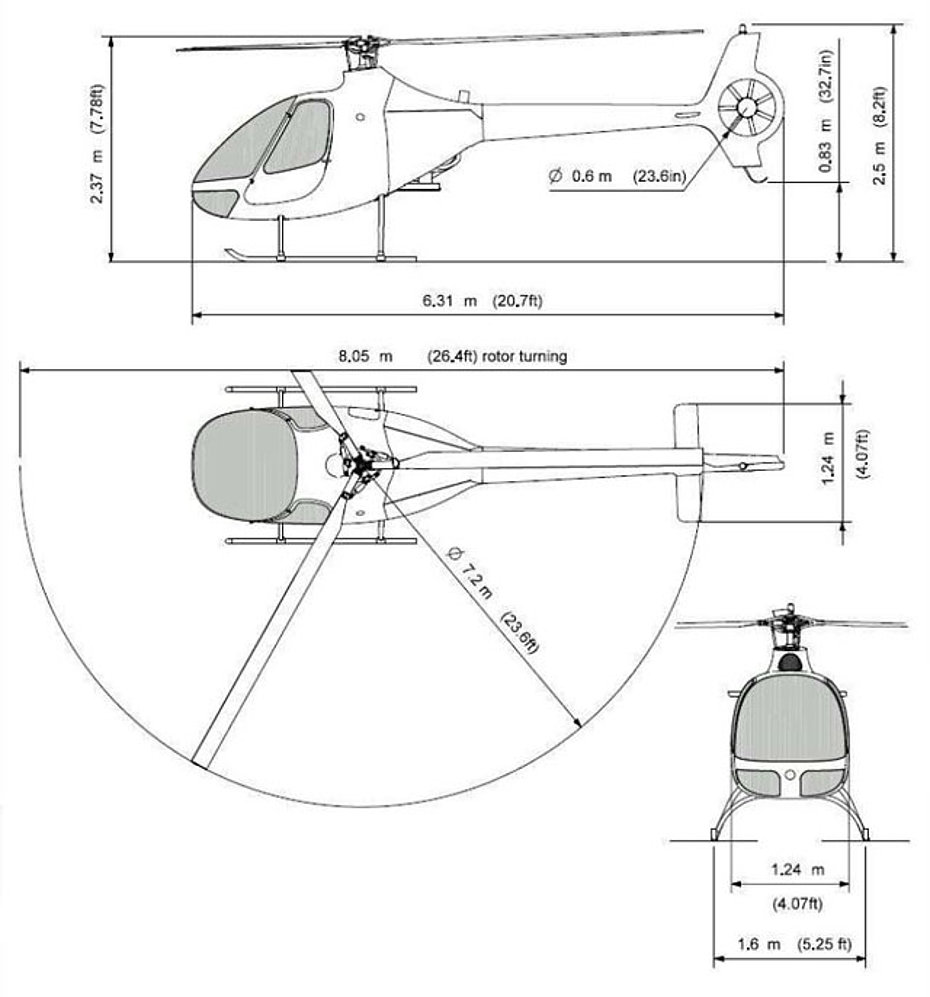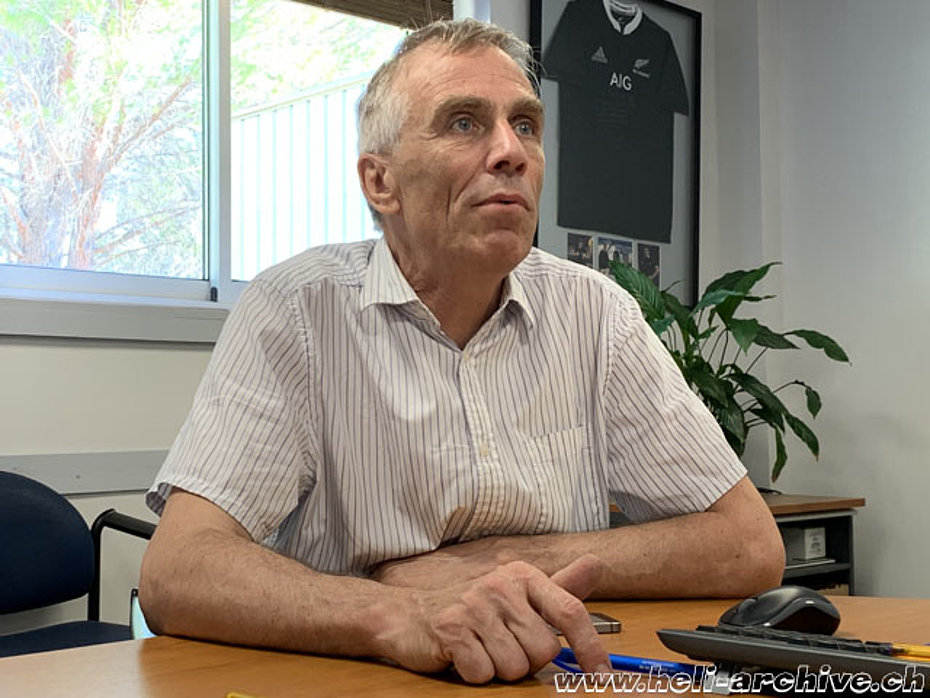
Guimbal Cabri G2 - History and technical description
Origins
Comfort in autorotation better with rotor inertia. With this idea in mind (which later became the acronym CABRI, a name thanks to which today the helicopter is known all over the world) the French engineer Bruno Guimbal in the early 1980s during his free time started working to design a two-seater aircraft.
He certainly could not have imagined that one day he would set up a company for the mass-production of a helicopter marketed around the world.
Bruno Guimbal, born on June 15, 1959 in Saint-Étienne (France), at a very young age developed a deep interest in mechanics, and after obtaining a professional certificate as an industrial designer at the École nationale supérieure d'arts et métiers (ENSAM) of Cluny, enrolled in the École nationale supérieure de techniques avancées for a specialization course at the end of which he obtained the qualification as an aeronautical engineer.
It was the summer of 1977 when he came up with the idea of building an airplane without ever having seen one closely. What at first seemed only a mad idea at a stage of his life ended up becoming his great passion and then his job.
But let's go back to the events of that summer. Bruno Guimbal, who at that time had just completed the enrollment exams for the high school, read in the journal "Science et Vie" an article about the ultra-light airplane CriCri designed by Michel Colomban.
Seduced by the idea of building that ultralight in the small family’s workshop of 25 square meters where he had already dismantled and reassembled mopeds and built a small catamaran, two weeks later he went to Rueil Malmaison to meet Colomban. On that occasion Bruno understood that the construction of the CriCri was too complex for his limited knowledges. Even the fact that the airplane was powered by two two-stroke engines did not really impress him much.
Anyway this did not discourage the young man. Shortly thereafter along with a friend he went to the airfield of Saint-Étienne Bouthéon to observe from close the airplanes. After visiting the hangar, an elderly pilot spontaneously offered the two boys the first flight and even if several years have passed he is still grateful to that man.
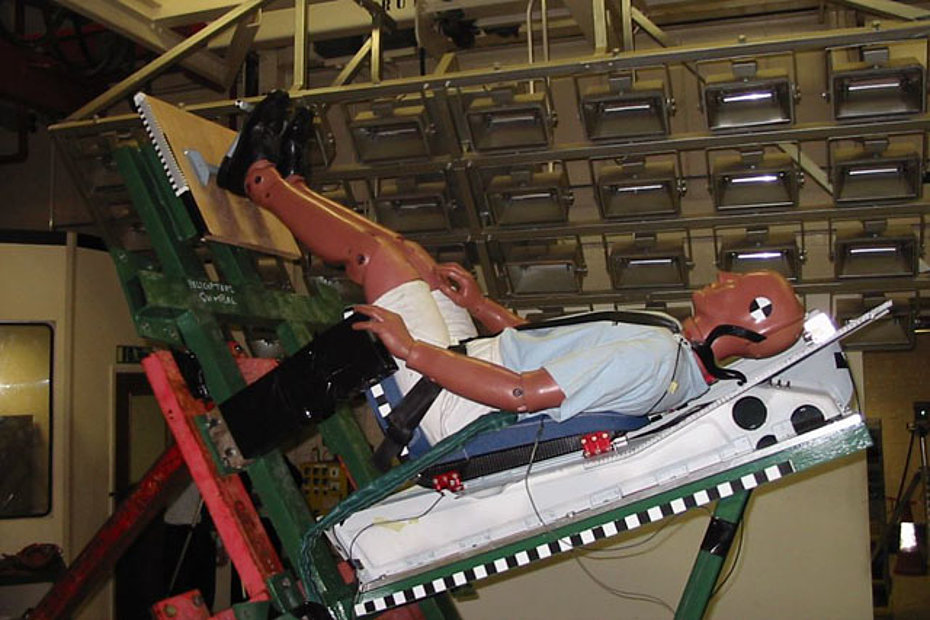
More or less in that period a pilot passed him an edition of the magazine "Les cahiers du RSA - Réseau du Sport de l'Air" which presented the VariEze, a home-built airplane designed by Burt Rutan.
To Bruno that airplane seemed to be conceived as his catamaran (which turned out to be completely false). That’s why he decided to purchase the kit and begin the construction.
A year later the VariEze was almost finished. Not without sacrifice, given his low-wage as a student-engineer, he managed to put aside some savings to start the pilot course on his airplane (the first in France of that type) thanks to a special authorization received from the Service de la formation aéronautique et du contrôle technique (SFACT). The following year he obtained the airplane pilot license. At the controls of his VariEze he did lots of flights throughout Europe and the United States (where he also met the designer Rutan) logging 1,200 hours of flight.
Aeronautical engineer
In 1981, at the end of the compulsory military service, the young engineer was hired by Aérospatiale and began to deal with the adaptation of a Fenestron for the Ecureuil, then the tail rotor of the Super Puma Mk. 2 and the rotor of the SA 365X Dauphin Grand Vitesse. He later held the position of deputy head of the EC-120 Colibri project, working on the main rotor and transmission and becoming a specialist in the construction of light helicopters.
The passion for his job was such that during his free time he began working on a two-seater light helicopter project conceived from the beginning to offer great protection to the occupants in the event of an accident, a target pursued by both the European Aviation Safety Agency (EASA), and Federal Aviation Administration (FAA), the agency of the US Department of Transportation with powers to regulate all aspects of civil aviation, including of course the certification of aircraft.
The Guimbal Cabri G2 meets the stringent EASA CS-27 and FAA FAR-27 regulations for helicopters with a maximum take-off weight of less than 3,175 kg/7,000 lbs.
The entire structure has been designed to meet the highest safety standards.
The helicopter features anti-crash seats capable of absorbing high g-loads up to 19g forward and up to 30g vertical, which corresponds to a free fall, a rate of about 10 meters/sec (2,000 feet per minute). The tests during which the forces exercised, for example on the belts, the vertebral column and the trajectory of occupants’ head, were measured at the Millbrook plants (England) under the strict supervision of the EASA.
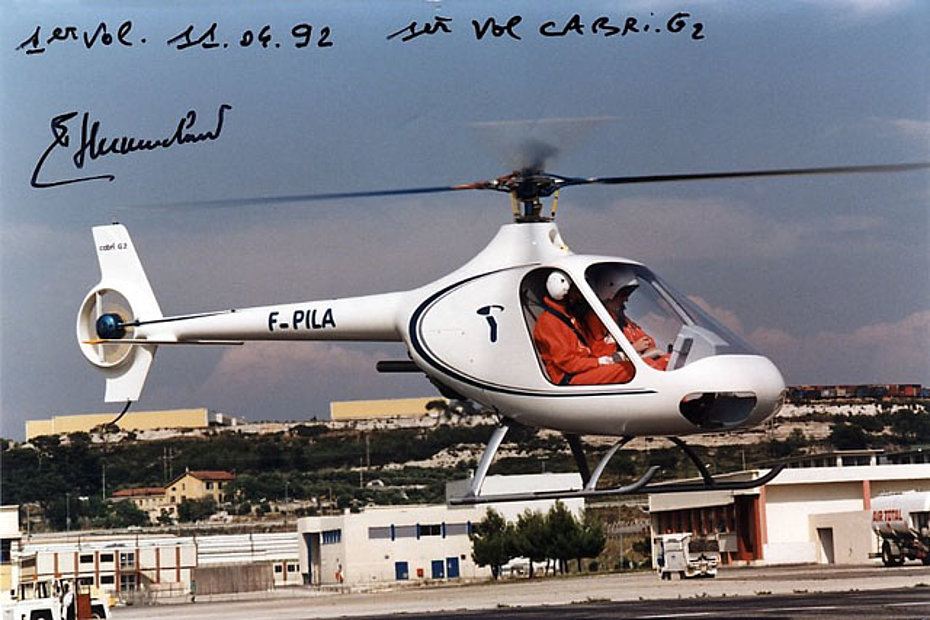
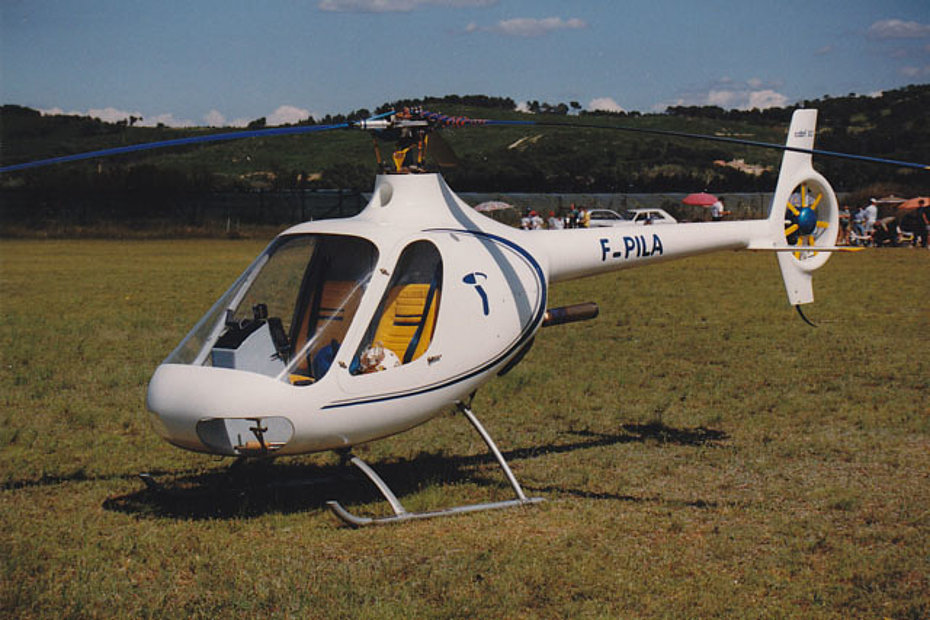
To further improve safety in the event of an impact, the fuel circuit is manufactured copying technologies used in the construction of combat helicopters and F1 cars: ultra-resistant double-structure tank, armored fittings, etc. In order to obtain the certification, the entire circuit underwent a test that included a free fall from a height of 15 meters. These trials significantly improved the occupants’ survival chances in the event of an accident.
As stated by the manufacturer it would have been unacceptable for the occupants to be better protected in an automobile rather than in a Cabri.
Passing these tests, besides being a very important stage in the certification program, classifies the Cabri as one of the safest helicopters in its class.
Now after this short but important premise, let's go back to the beginnings of our tale.
In 1982, during a meeting of the Fédération RSA Bruno Guimbal showed the three-view drawings of a helicopter known as Helica (acronym of Hélicoptère de Construction Amateur) to a friend. As time passed and the project advanced, the engineer's enthusiasm started to infect friends and work colleagues who began in various ways to help him, to support and encourage him.
Even his employer started to gradually focus his interest in the project to the point that Guimbal and Aérospatiale (then Eurocopter since 1992) decided to sign an agreement that included for example the possibility for the former to invest part of his working time in the development of the Cabri, to use expensive technical equipment and to get the necessary technical assistance during testing. On the other side several patents concerning new technologies used on the Cabri and developed by Guimbal were deposited on behalf of the French manufacturer.
The construction of the prototype
The design and the construction of the prototype obviously absorbed a lot of energies.
Thanks to a special certificate (Certificat de navigabilité restreint d'aéronef) issued by the Direction générale de l'aviation civile the prototype with the call sign F-PILA started the first test flights in Marignane on April 11, 1992 in the expert hands of test pilot Etienne Herrenschmidt and flight engineer Bernard Certain.
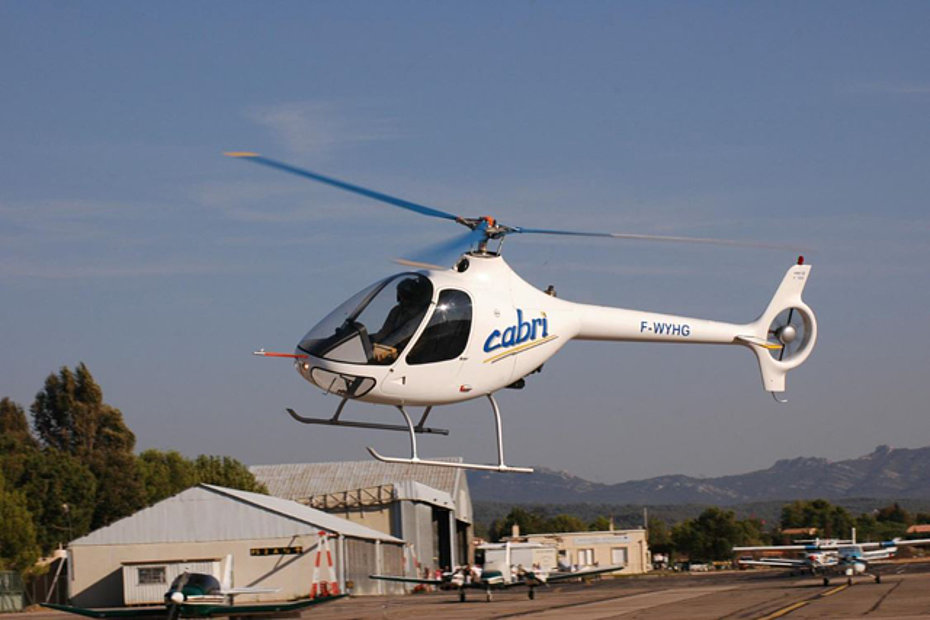
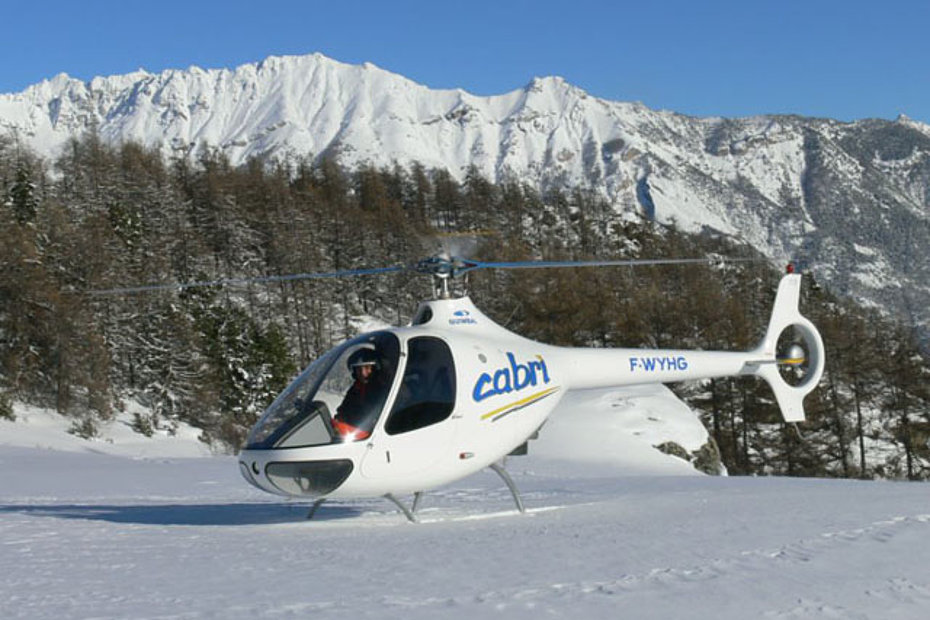
After the usual “childhood problems” were overcome a part of the test flights were carried out by the same designer who in the meantime had obtained the helicopter pilot license. Overall, the prototype accumulated around 150 flying hours during which it was piloted by 18 pilots, 3 of whom were test pilots.
On May 22, 1996 Claude Aubé (1932-2013), employed for many years as a test pilot on behalf of Sud Aviation/Aérospatiale, using F-PILA set a new world distance record for light helicopters with piston engines with a weight of less than 500 kg (category E-1a) covering a distance of 481.34 km.
Thanks to this record, which is still valid, the interest around the helicopter slowly started to grow.
Birth of Hélicoptères Guimbal
Given the excellent performance of the aircraft and the existence of a potential market, on September 8, 2000 the then 41-year-old engineer decided to leave Eurocopter to found the public limited company Hélicopterères Guimbal at the airfield of Aix-en-Provence in order to mass-produce the Guimbal Cabri G2.
Very similar to its predecessor the first pre-series aircraft with call sign F-WYHG made its inaugural test flight on March 31, 2005 with test pilot Olivier Gensse.
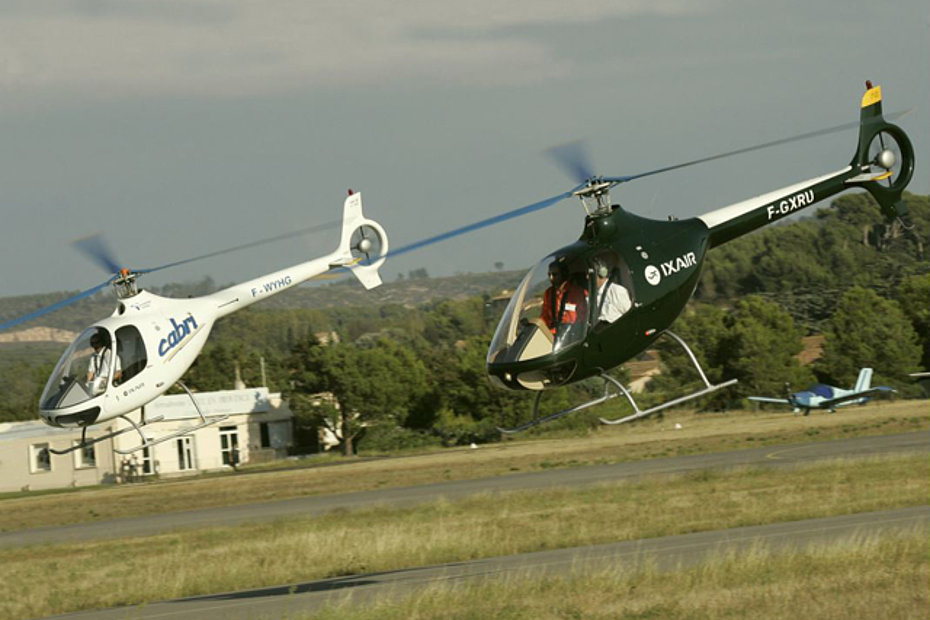
It differed from the predecessor for a series of changes and improvements among which there were for example the adoption of a more powerful Lycoming O-360 engine with a new exhaust pipe that replaced the 112/150 kW/hp Lycoming O-320 E2A, a new tail rotor transmission, a new horizontal stabilizer, a redesigned Fenestrôn, a new landing gear.
A few months later at the 46th Paris Air Show (June 13-19, 2005), Eurocopter and Hélicoptères Guimbal officially signed an agreement to create Vertivision, a joint-venture aimed at developing, industrializing, marketing and supporting a reconnaissance drone known as Vertivision Cabri.
That same year on August 21 in Rouen, Olivier Gensse, at the controls of F-WYHG, set three new world records in the category E-1a: absolute altitude record without load (6,658 m), time to climb to 3,000 meters (6'62") and time to climb to 6,000 meters (22'6").
After years of development in order to meet the EASA’s demanding certification requirements, Hélicoptères Guimbal performed 300 flight test hours and many ground tests over a period of two and a half years. Finally on December 15, 2007 at Le Bourget, Alain Leroy Head of the Product Department on behalf of EASA handed over the type-certificate to Bruno Guimbal.
Before a newly developed aircraft model may enter into operation, it must obtain a type certificate from the responsible aviation regulatory authority. Since 2003, EASA is responsible for the certification of aircraft in the EU and for some European non-EU Countries.
Thanks to this document, the French manufacturer was finally allowed to follow up the orders that had already been accumulated since June 2006.
On September 19, 2008, Hélicoptères Guimbal delivered the first Cabri (F-GXRU s/n 1003) to IXAIR, one of the leading French operators. On that occasion, the new 2,000 sqm workshop was inaugurated at the Aix-les-Milles aerodrome in Provence.
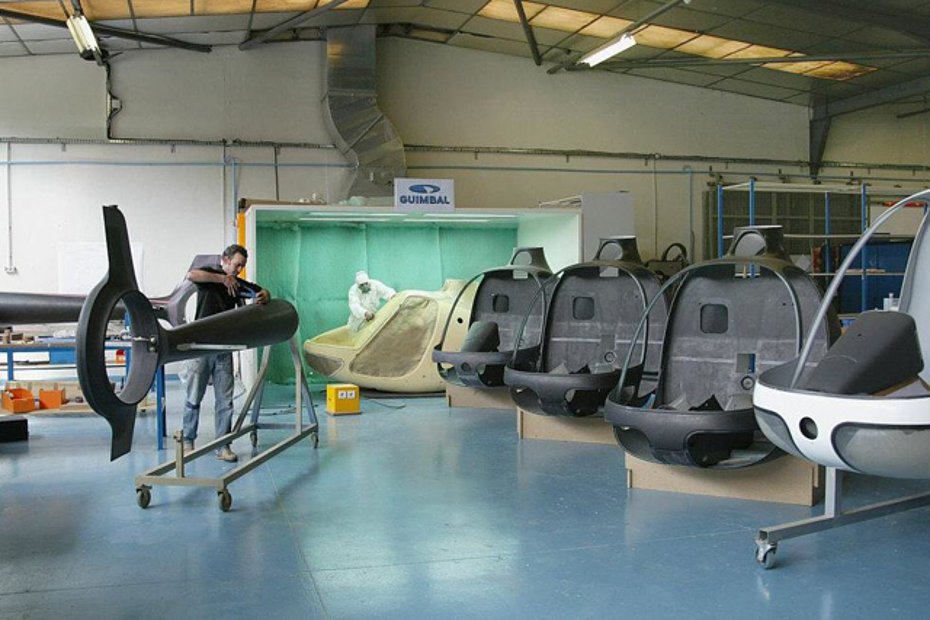
However for the tenacious entrepreneur that was a very difficult period. The financial crisis triggered a few days before by the bankruptcy of Lehmann Brothers directly touched the young French company.
After this crisis, and the fear of potential customers who felt that the young company would have closed its doors prematurely, thanks to the confidence gained by some important operators sales slowly took off.
That same year (2008) Bruno Guimbal won the engineer's award in the "industrial projects" category assigned by the magazine Usine Nouvelle. In the meantime, other recognitions have been added to this award, confirming the talent of the French manufacturer.
With the obtaining of the certificate No. R00005RD issued by the Federal Aviation Administration (FAA) on January 25, 2015, Guimbal Hélicoptères was officially authorized to start the distribution of its two-seater in the USA. There, as already told, the sale of light helicopters was almost "monopolized" in the early 1980s by Robinson Helicopters with the introduction of the R-22, a helicopter with which the Guimbal G2 Cabri has now entered into open competition.
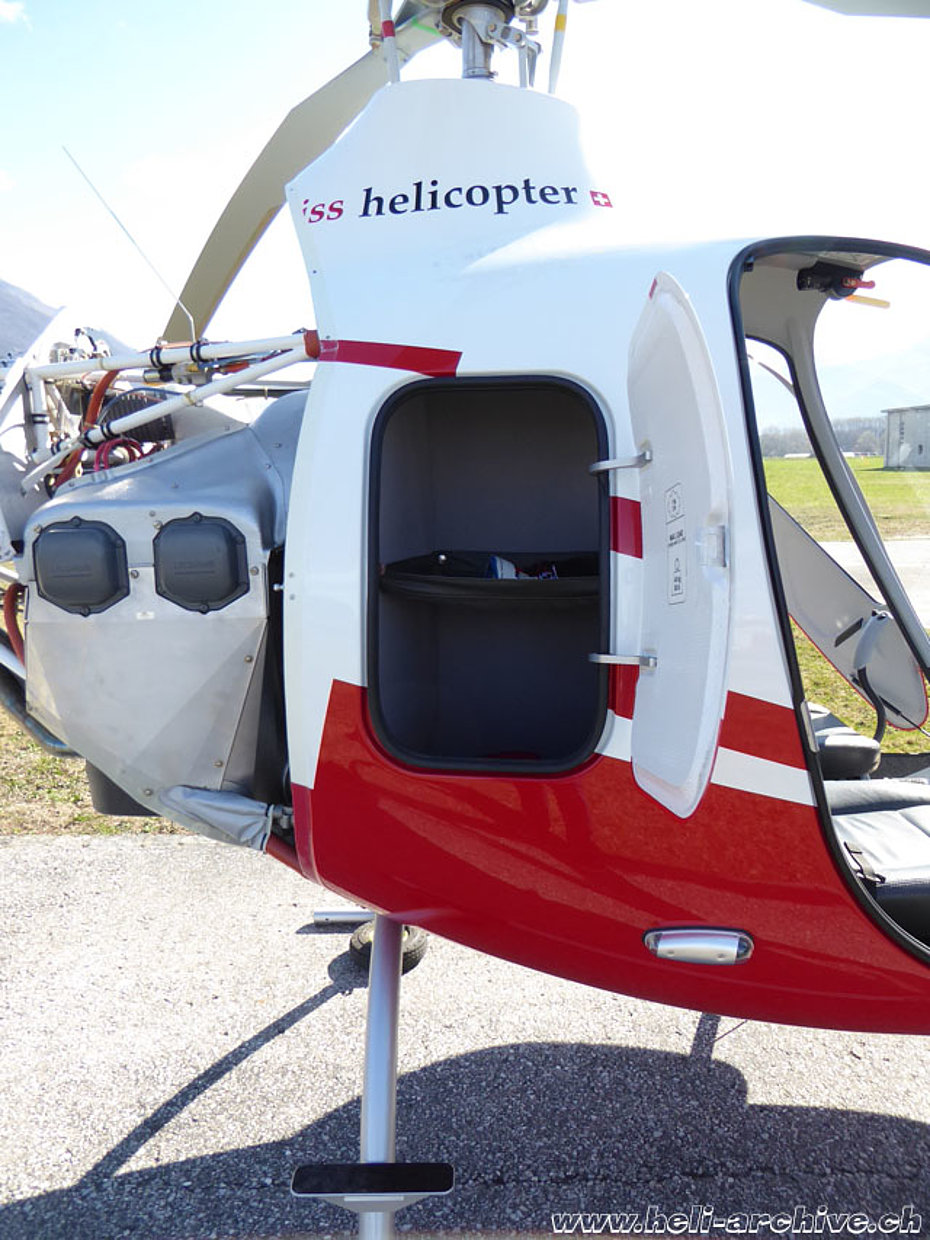
On May 18, 2015, the French manufacturer delivered the 100th aircraft and concluded the year with a turnover of 14.6 million euros, a 60% increase compared to 2014.
Despite being on average at least 30% more expensive than a Robinson R-22 Beta II with standard equipment (whose price in January 2018 amounted to about $ 297,000), for some years now this helicopter occupies the first place in the sale ranking list of light piston helicopters. The company that last year (2017) employed about eighty employees has invested a lot and has hired new personnel to cope with the orders: the 200th aircraft has left the assembly line in 2017.
At the end of last year, the fleet of the 210 Cabris in service in more than 30 countries all over the world had logged altogether over 150,000 flight hours, a great achievement and a great satisfaction for a boy who started to move his first steps in the aviation world as self-taught in the family’s workshop therefore… chapeau Monsieur Guimbal!
Civil employment
The helicopter is designed to be primarily used to train pilots, for private transportation and activities such as aerial photography and observation.
Technical description
The Guimbal G2 Cabri is a light two-seater helicopter of conventional design that includes, as we will see, some important technological innovations that are normally found only on helicopters of the latest generation or belonging to a higher price category. These greatly improve both active and passive safety. The airframe built almost entirely with composite materials weighs approximately 70 kg (164.3 lb) equivalent to about 16% of the empty weight and is composed of three sections:
-
the main fuselage, including cabin, central structure, baggage and fuel compartments;
-
the engine section, isolated between a front and an aft firewalls;
-
the tail boom;
The monocoque cabin is made up of five carbon-fiber reinforced parts and has two seats side by side with the pilot occupying the right-hand position.
As previously mentioned, the helicopter was designed to offer great protection to its occupants in the event of an accident. For this reason, in addition to the landing gear and the structure, the seats have been designed to absorb shocks and are mounted on special tracks equipped with shock-absorbers that dampen the violence of the impact.
Behind the pilot's seat there is a large luggage compartment with a capacity of 200 liters where, respecting the limits, up to 40 kg of luggage can be loaded in the lower part and 1 kg in the upper one. The latter compartment is accessible during the flight, and can be used to store small objects (a map, a jacket or a camera).
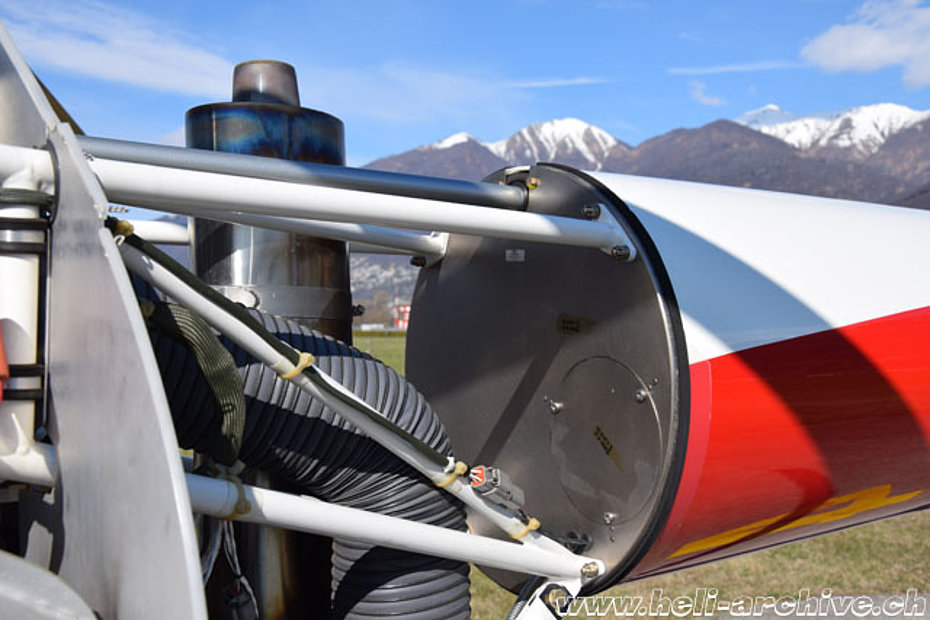
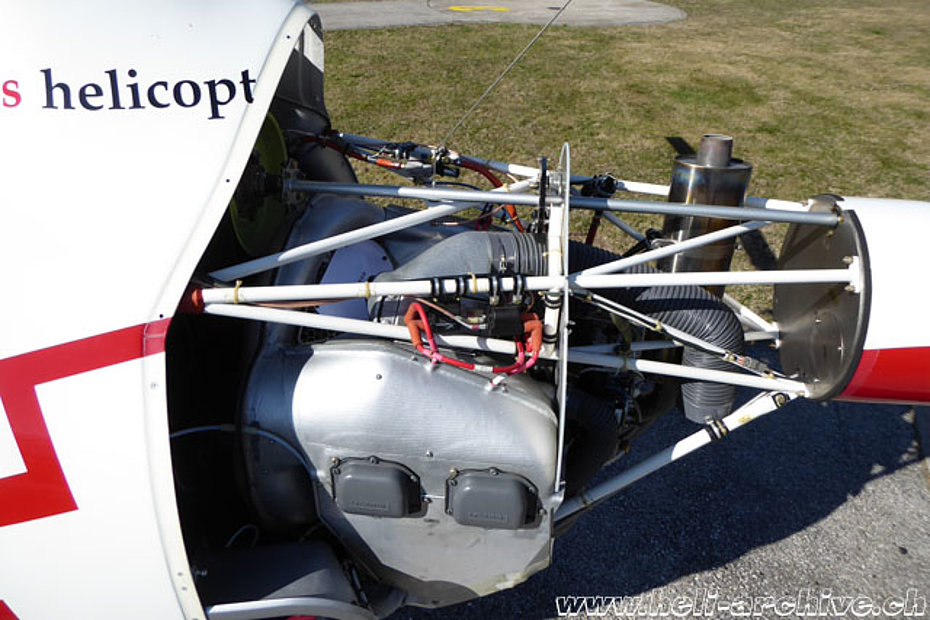
The helicopter has a smaller compartment (capacity 20 liters) located under the instrument panel on the passenger side where it is possible to store up 5 kg (20 pounds). Here for example it is possible to put away the double controls when not installed.
The central structure, made of welded steel tubes, has been designed to absorb all the bending and rotating forces of the engine and the tail boom. The engine is installed in this section, isolated at the front and rear by titanium fire walls. The engine compartment is protected by hinged side panels constructed of composite materials that can be opened upward during the inspections.
The Fenestron with vertical fin incorporated and horizontal stabilizer is integrated into the monocoque tail boom.
The complete tail boom weights only 7 kg. It is bolted to the central section by means of four supports but has no reinforcement spars.
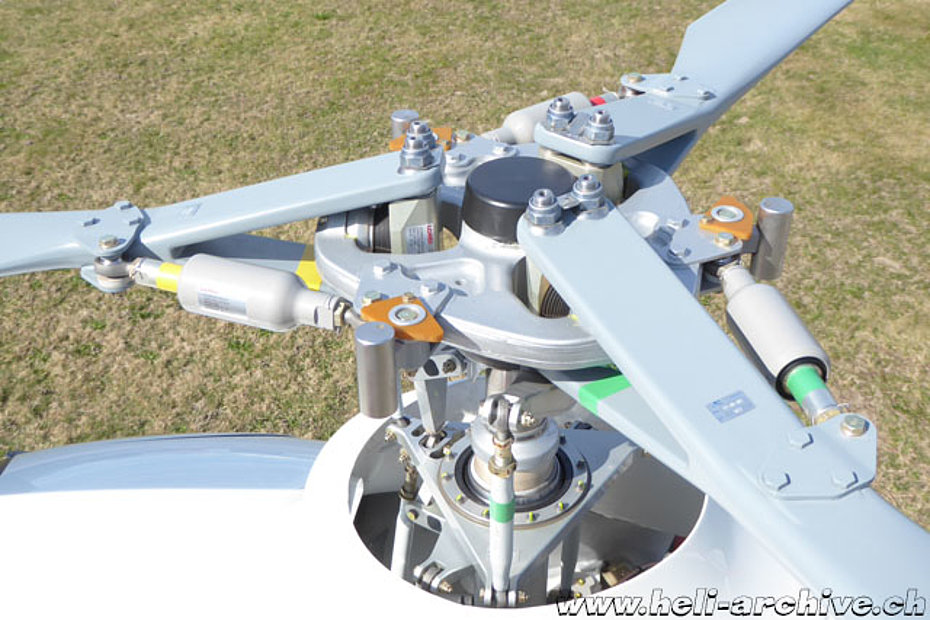
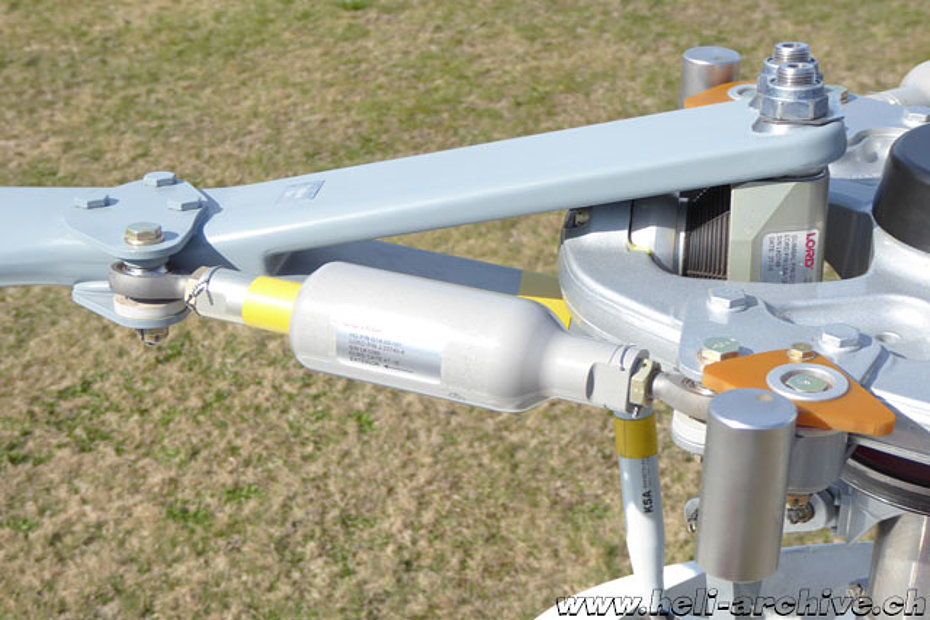
The drive shaft is housed in the tail boom and is suspended by means of three bearings that can be inspected with a flashlight through two small inspection holes. The transmission shaft is connected to the front of the upper transmission pulley by a coupling. In the rear it is attached to the bevel gear of the tail rotor.
The main landing gear is composed of two tubular bows (in order to absorb the impacts), and two skids. It is attached to the fuselage by soft elastomeric mounts, giving adequate frequency to avoid potential ground resonance problems. Four carbide plates protect the skids against damages due to abrasion.
To displace the helicopter on the ground two wheels can be rapidly applied to the skids and stored in the luggage compartment.
Main rotor
The Guimbal G2 Cabri has a three blades articulated rotor of the Spheriflex type, an evolution of the previous Starflex installed for example on the AS 350 Ecureuil.
Patented in 1977 and developed since November 1982 to be mounted on the AS 332 Super Puma, the Spheriflex is designed for low maintenance and compared to its predecessors incorporates significant advances in terms of lightness, safety, reliability and assures a reduced vibration level. Its compactness also means less aerodynamic drag and allows a slight increase in speed.
For comparison the rotor head of the SA 318 Alouette II includes 30 bearings, 45 seals and 22 greasing points!
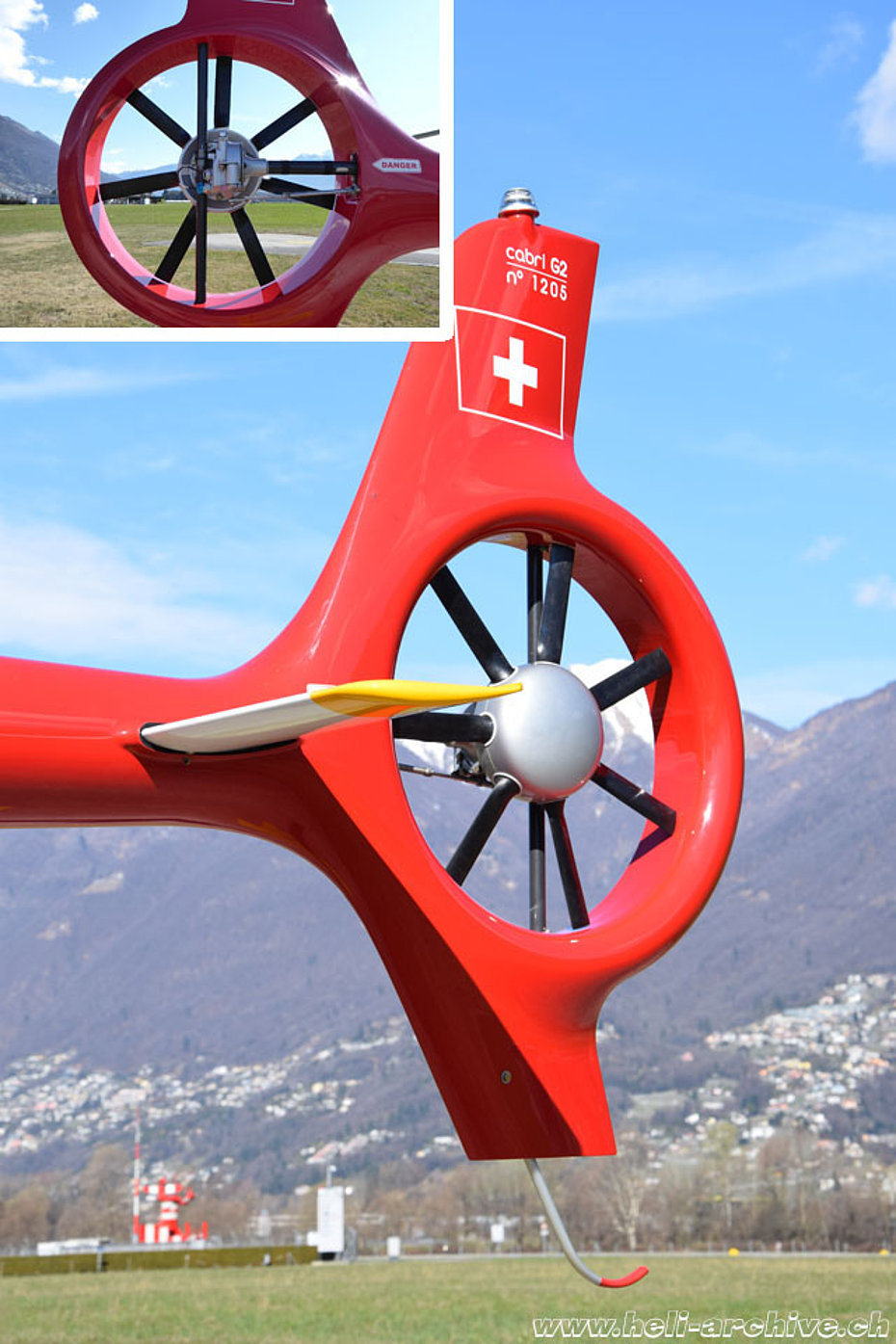
The rotor hub is forged from aluminum alloy, and attached to the stainless-steel mast, by a large splines and cones attachment, with a thrust nut. The hub is belted with a tough fiberglass winding, which increases its tolerance to damage.
The blades weight each about 13 kg, have a chord of 180 mm and are made of high-grade fiberglass filament winding, with carbon fiber skins, and PMA foam core. They are protected against erosion due to sand, dust and precipitations by a thick CR steel leading edge cap, and against lightning damage by copper mesh and a copper foil. They include a plain steel tip mass, with four balancing cavities.
The rotor inertia is nearly twice compared to the R-22 and 40% higher than the standards requested by the US Armed Forces.
The blades are linked to the rotor hub via an elastomeric lead-lag damper, made of a single cylindrical layer of special rubber. The blades are restrained in flapping-down, by a reciprocal droop-stop ring guided in the rotor hub. They are restrained in flapping-up by an upper positive stop.
Elastomeric bearings are constructed from a rubber type material and have limited movement making them perfect for helicopter applications. Flexures and elastomeric bearings require no lubrication and therefore as said require less maintenance. They also absorb vibration, which means less fatigue and longer service life for the helicopter components.
The peculiarities of the Spheriflex translate into a quick response to pilot’s inputs. This means excellent maneuverability and stability but the price to pay is a certain rigidity in the controls. Thus their actuation requires some muscle strength.
Tail rotor
The Guimbal Cabri G2 has a Fenestrôn tail rotor with a diameter of 60 cm that comprises a hub made of two forged and machined aluminum parts bolted together. The hub is rigidly supported inside the shroud by a three-tubes mount.
The Fenestrôn has seven reinforced plastic-injected blades (chord 42 mm) controlled by the pitch spider.
The front tube houses the tail rotor driving shaft that drives the tail gearbox.
The hub houses the pitch control mechanism, the tail rotor gearbox oil level indicator and the magnetic chip detector, an electronic instrument that attracts ferromagnetic particles and warns the pilot of unusual wear problems.
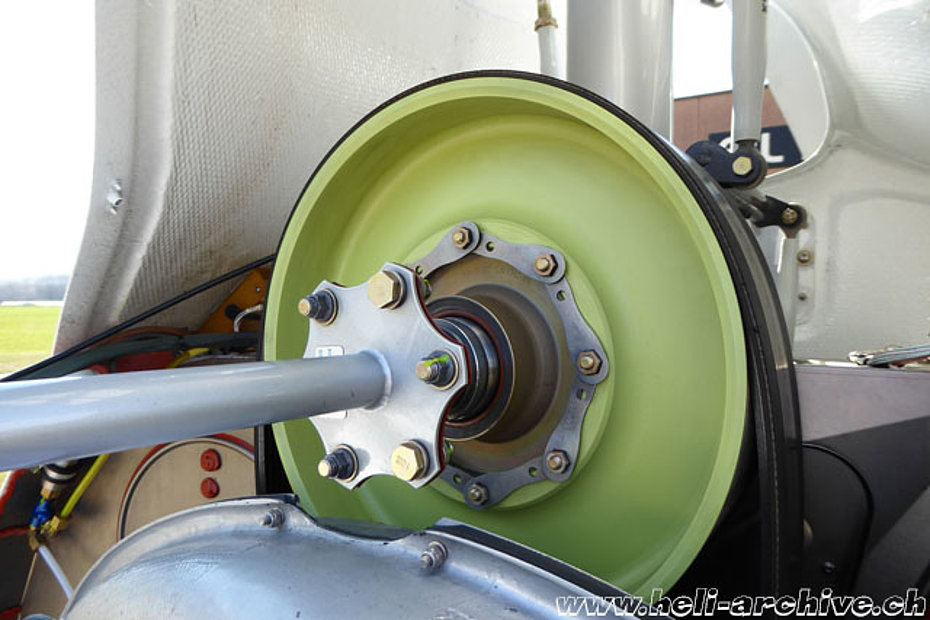
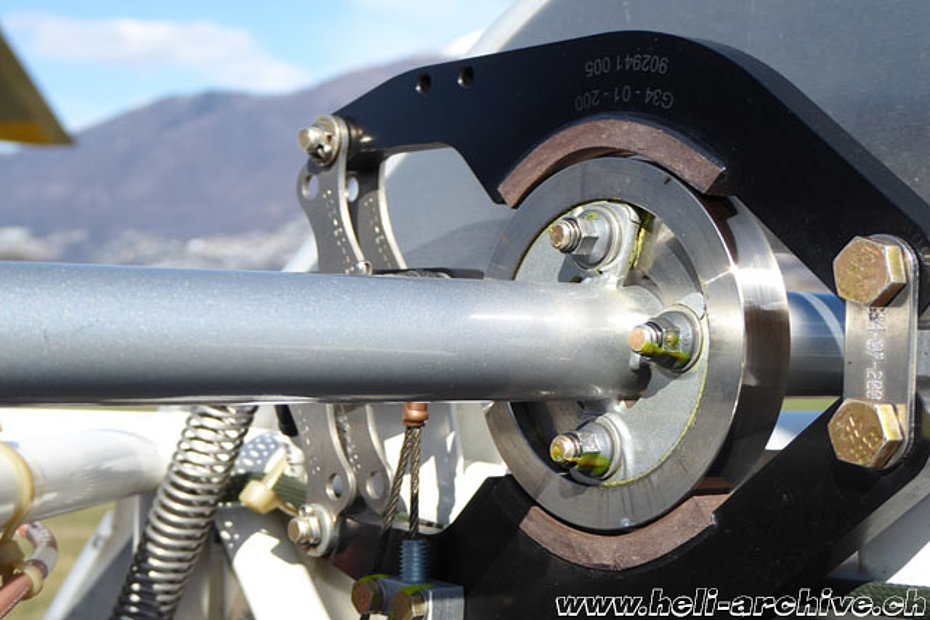
Notably, the reaction times of the Fenestrôn are a little slower and not linear compared to conventional tail rotors. During certain flight manoeuvres, the power input required to obtain the desired thrust is generally greater.
Among the main advantages of this type of rotors there are an improved aerodynamic, the reduced noise and vibration level and the increased safety for people on the ground because the enclosure provides peripheral protection.
A bumper is mounted at the bottom of the Fenestrôn.
Transmission
The primary transmission comprises a pulley directly bolted to the engine output flange (ratio 0.855/1), a poly-V belt transmitting the power, and an upper pulley connected through to the gearbox input. The freewheel unit is located inside this pulley and allows the main rotor to rotate and to drive the tail rotor, should the engine stop. The power is transmitted forward to main gearbox and aft to the tail rotor transmission.
The main gearbox contains a splash-lubricated spiral bevel-gear set which transmits power to the rotor mast (ratio 11/47). It is equipped with a filler plug/breather, a sight gauge and a self-closing magnetic chip detector.
The main gearbox upper and lower casings act as a tough central structure rigidly bolted in the middle of the fuselage structure.
The steel tail rotor transmission shaft runs inside the tail cone, on three ball bearings.
A disc rotor brake is installed on the fore portion of tail transmission shaft. The brake jaws are actuated through a cable control, from an overhead control quadrant.
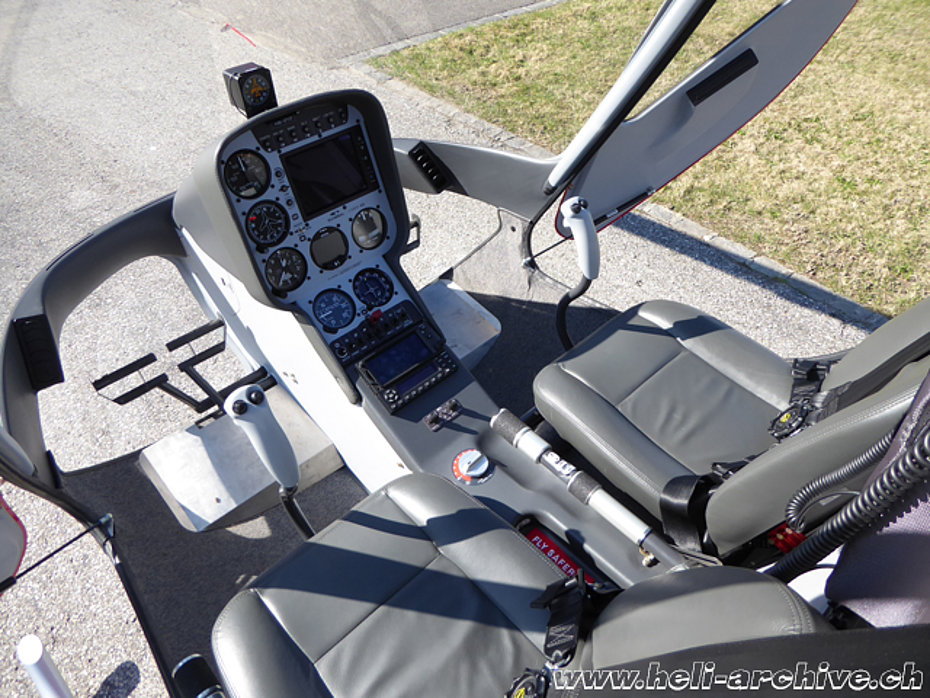
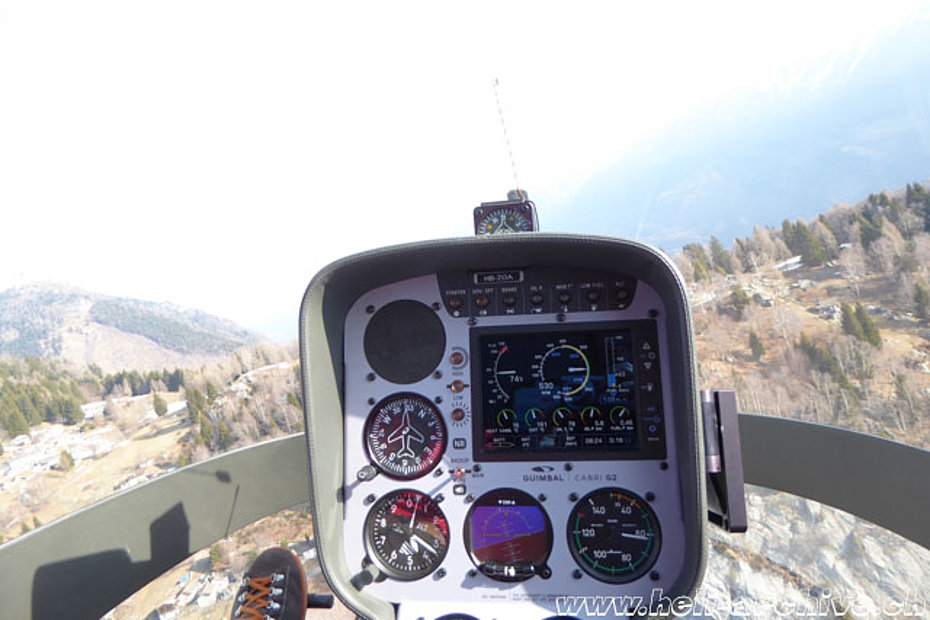
The tail gearbox contains a splash-lubricated spiral bevel-gear set which transmits power to the tail rotor. It also incorporates the tail rotor pitch control mechanism. It is equipped with a filler plug/breather, a sight gage and a self-closing magnetic chip detector.
Flight controls
The Cabri G2 has conventional flight controls which include cyclic stick, pitch and pedals. Co-pilot controls are quickly removable without tools. Cyclic and collective controls actuate main rotor blades pitch through push-pull rods, bellcranks and the swashplate. Yaw control is transmitted from the pedals to the tail rotor by a long flexible push-pull control.
The collective stick grip is divided into one fixed part and one twist-grip to enable sensitive throttle control and to allow governor motion.
A cam mechanism provides adequate throttle correlation throughout the power range but when the governor is switched on an electronic device maintains automatically and with great precision the rpm in the green arc.
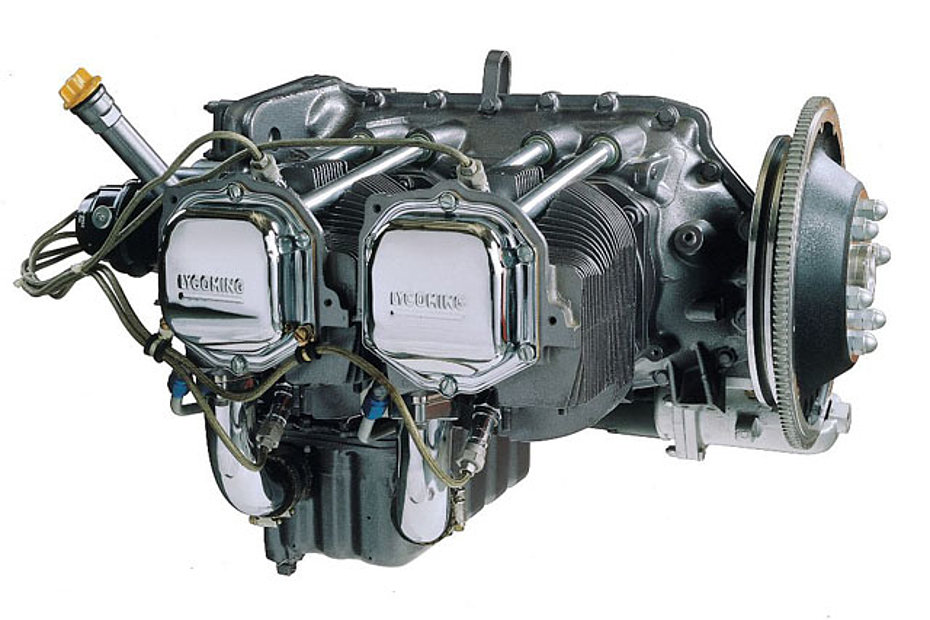
The pitch incorporates a gas spring that compensate undesired motion in every flight phase and reduce the muscle strength. A friction mechanism blocks the pitch when necessary.
Engine
The helicopter is powered by a 5,900 cubic centimeter (360 cu in) four-cylinder, direct-drive, air-cooled Lycoming O-360-J2A. The engine is installed in the centre section, aft of the main gearbox, with its crankshaft facing forward. It is suspended through elastomeric vibration mounts.
Hélicoptères Guimbal has replaced one of the two Bendix magnetos with an electronic LSE Plasma II HG magneto, which, among other things, facilitates the engine start.
The engine is fed by a single 170 litres (45 USG) fuel tank, located between the firewall and the cabin bulkhead, on the left side.
Although the engine is capable to develop a maximum output power of 134/180 kW/hp, on the Guimbal Cabri G2 the maximum power is de-rated to 119/160 kW/hp at 2,585-2,700 rpm.
The transmission is rated for 108/145 kW/hp (100% PWR on the Multiple Limit Indicator - MLI display) continuous power.
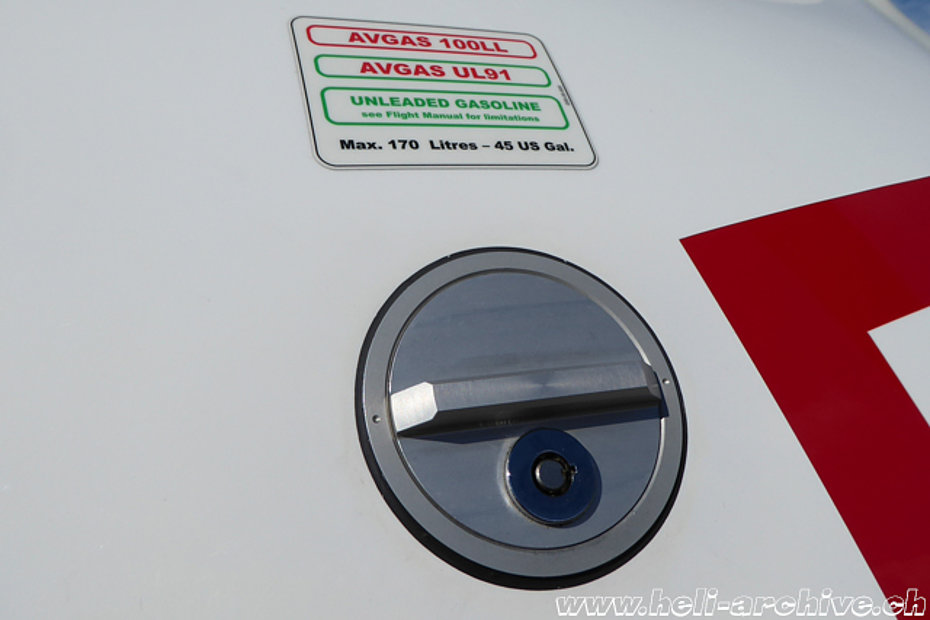
In November 2017 Hélicoptères Guimbal has received from EASA/FAA approval for a 11/15 kW/hp upgrade for the Cabri G2. This extra power is usually exploited during take-off and it is limited to 5 minutes.
Operators must download a new software into the aircraft’s EPM (which is similar to the Airbus VEMD) in order to obtain this upgrade.
Cooling is supplied by an engine-mounted fanwheel enclosed in a carbon fiber scroll. The scroll ducts cooling air to the engine-mounted shroud which in turn directs the air to cylinders, oil cooler, alternator and cabin heater.
The Cabri G2 is fully certified to use unleaded Avgas and unleaded automotive gasoline but in the second case some additional parameters specified in the flight manual must be strictly observed. The take-off power for example is always limited to 108/145 kW/cv.
The helicopter is fitted with an automatic carburetor heat system.
In order to reduce the noise signature the exhaust manifolds flow into a single exhaust pipe and the exhaust gases go straight up into the rotor flow.
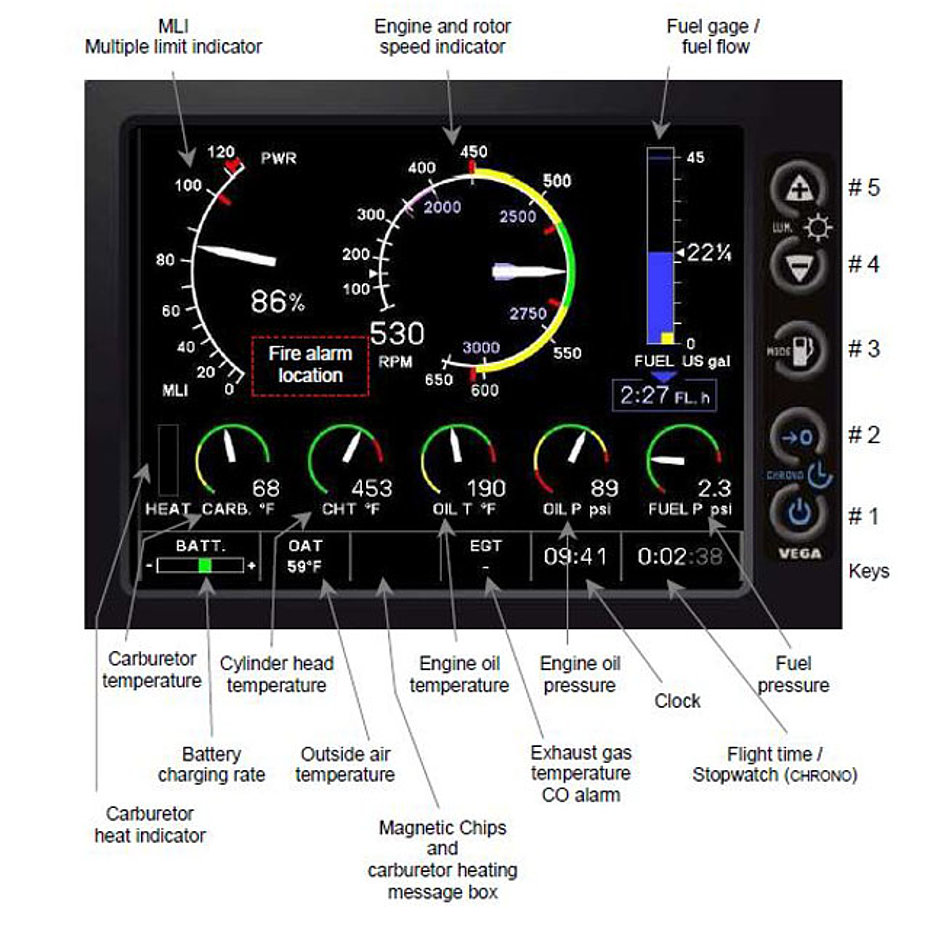
Avionics
The standard flight instruments include airspeed indicator, altimeter, vertical speed indicator, magnetic compass and the Electronic Pilot Management (EPM) system, the digital instrumentation of the aircraft's glass cockpit. The list with the indicators displayed on the EPM include:
- multiple limit indicator (MLI)
- engine- and rotor-speed
- amount of fuel
- fire warning
- operating status of the carburetor pre-heating and carburetor temperature
- cylinder head temperature
- oil temperature
- oil pressure
- fuel pressure
- operating status of the battery
- outside air temperature
Intended to be intuitive, the EPM monitors 36 parameters and uses three screens to display critical aircraft and engine information. The EPM also provides advanced functions such as for example smart power indicator, advanced fuel computer and automatic carburetor heating. It also lists the last 15 flights take-off and landing times and very precisely shows the average fuel consumption, fuel level and the remaining flight time.
The multiple limit indicator (MLI) is another feature of the Guimbal Cabri G2: it shows on the red line the available power and limitations at a glance.
The EPM is controlled using five buttons located on the right hand side of the display panel.
Above the EPM there are seven visual indicators which display system status or warnings independent of the EPM by illuminating a yellow or red light. From left to right, these are the indicators for the electric starter, automatic governor, rotor brake, oil pressure, temperature in the main transmission, low fuel warning and alternator.
The manufacturer uses the acronym BARC for the rotor and fuel alarm device whose indicators are located to the left of the EPM. As a backup to the EPM, the system generates visual and acoustic signals to inform the pilot on the current speed of the main rotor.
Standard accessories
The list of standard equipments includes:
-
dual controls;
-
secure keyless entry and anti-theft device;
-
cabin heating and vents;
-
music input and power outlet to charge cell phone, cameras, GPS, tablets;
-
rotor brake;
-
documents bag;
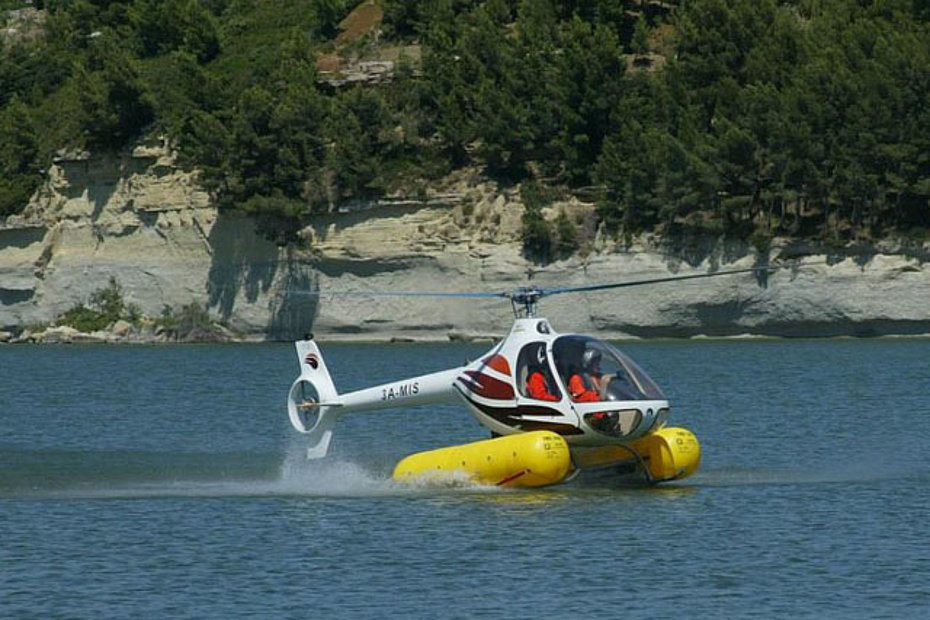
Optional accessories
The Guimbal G2 Cabri can be equipped with a choice of instruments for night VFR flight, GPS, emergency inflatable floats, air conditioning, barycentric hook (maximum lifting capacity 220 kg/485 lbs), and bear paws to land on soft ground.
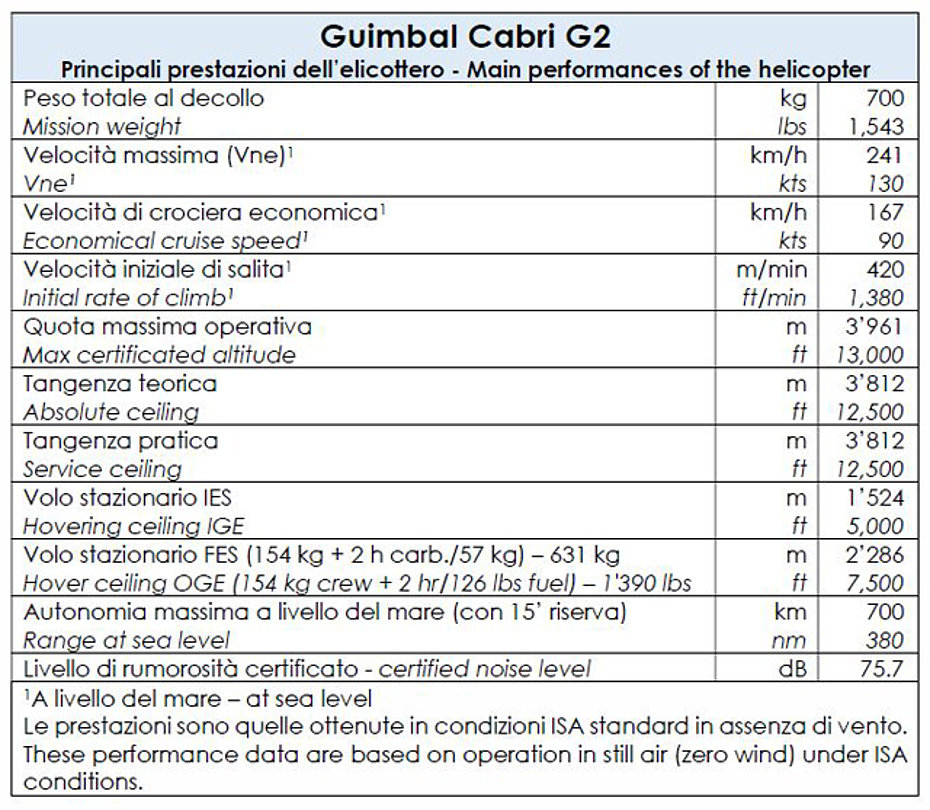
The empty weight of the helicopter is about 425 kg (937 lb), while the maximum takeoff weight is 700 kg (1,543 lb). The payload is around 275 kg (606 lb).
Up to 40 kg (88 lb) can be carried in the main luggage compartment, while up to 5 kg (11 lb) can be stowed in the forward luggage compartment.
Performances
The main performances of the Guimbal Cabri G2 are resumed in this table:
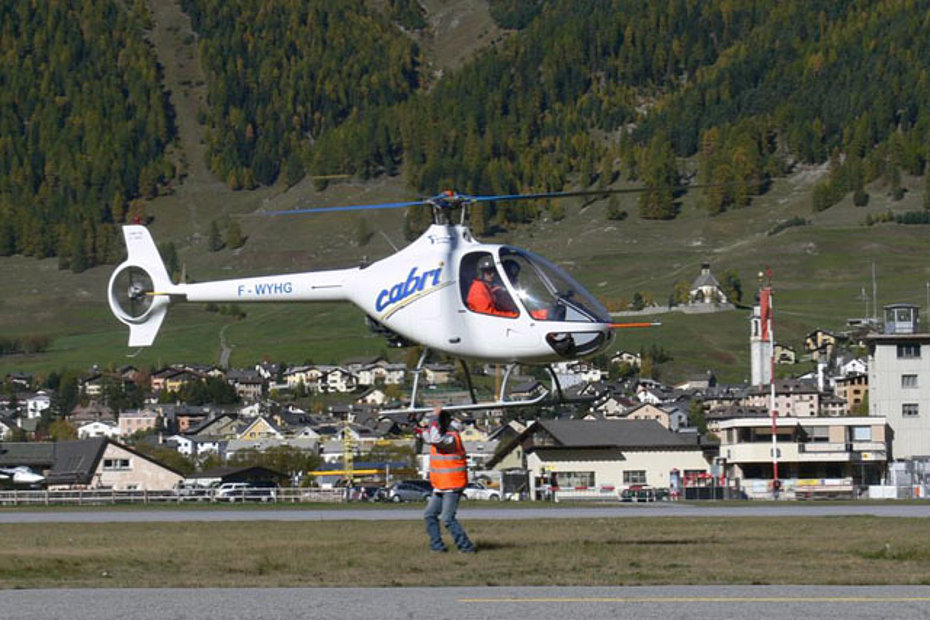
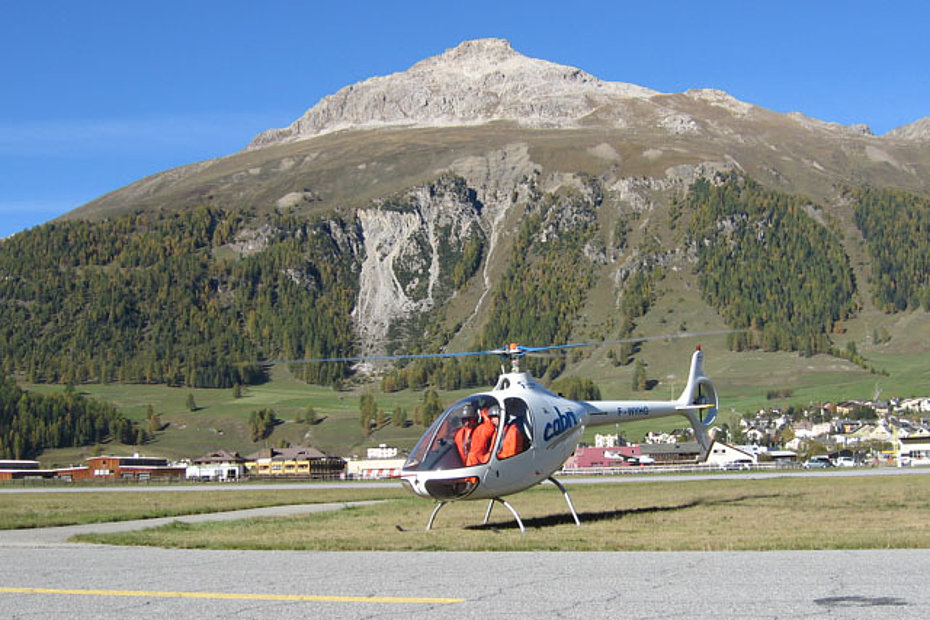
The Guimbal Cabri G2 in Switzerland
In all likelihood the Guimbal Cabri G2 did its first official appearance in Switzerland in October 2006 when the first pre-series model with call sign F-WYHG piloted by Oliver Gensse was tested at the alpine airport of Samedan/GR (1,707 m 5,600 ft MSL). On that occasion various data referred to the performance and the behavior of the aircraft at high altitude helicopter were collected.
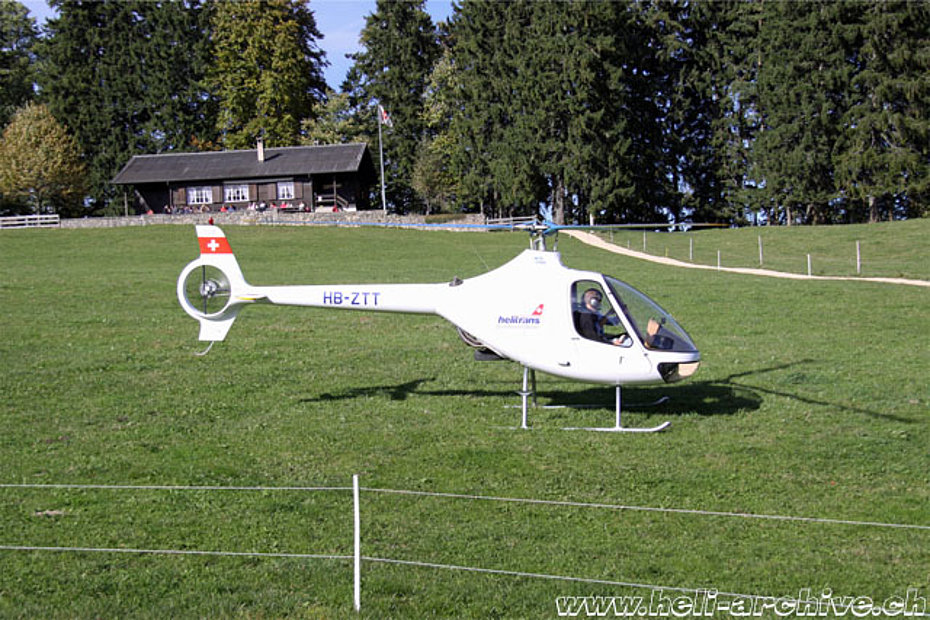
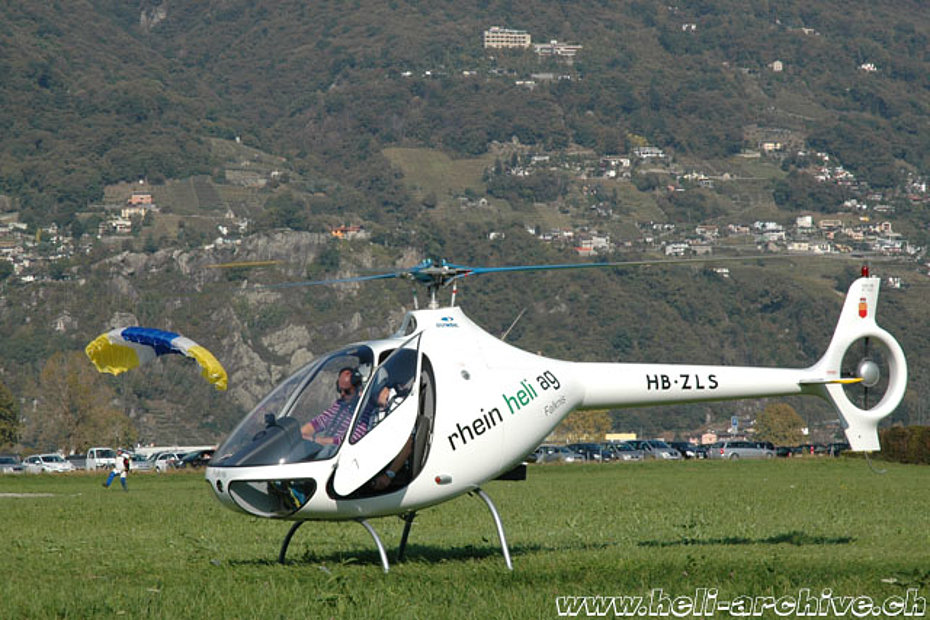
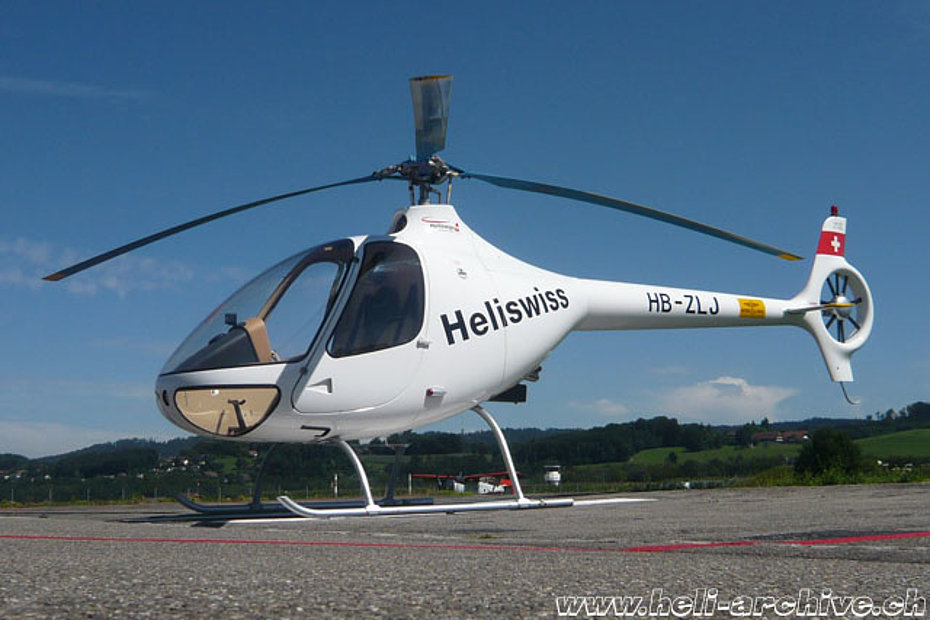
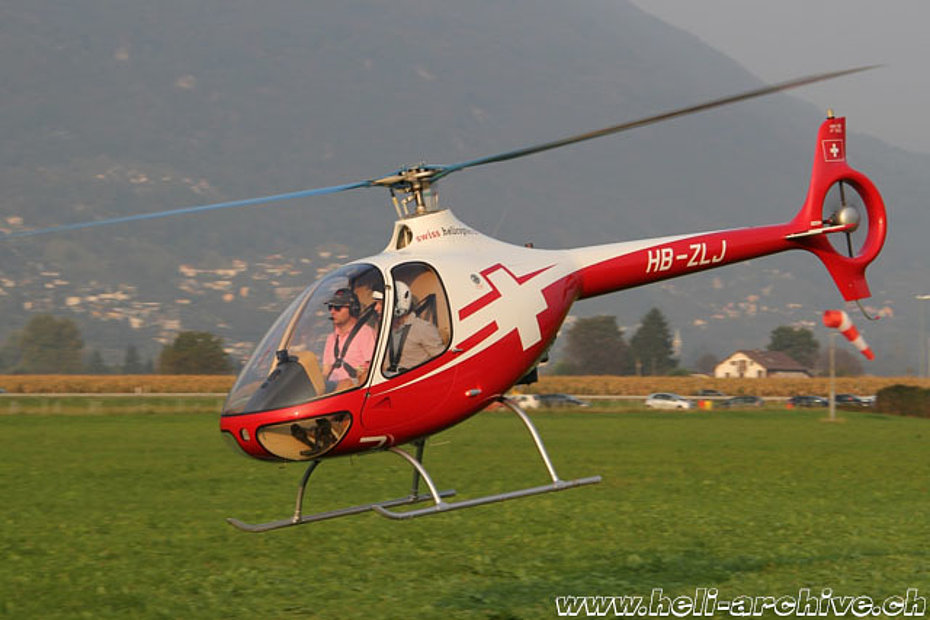
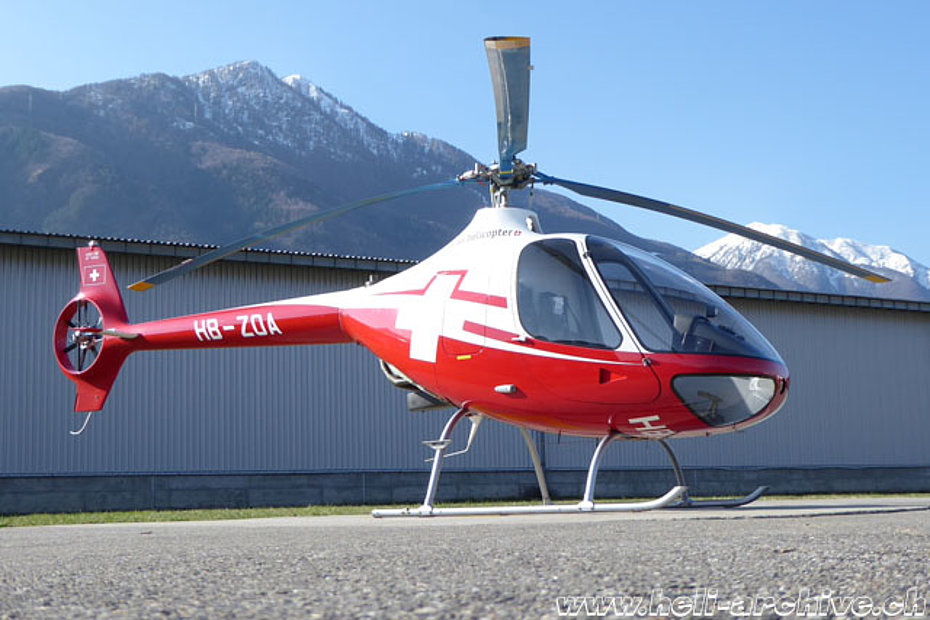
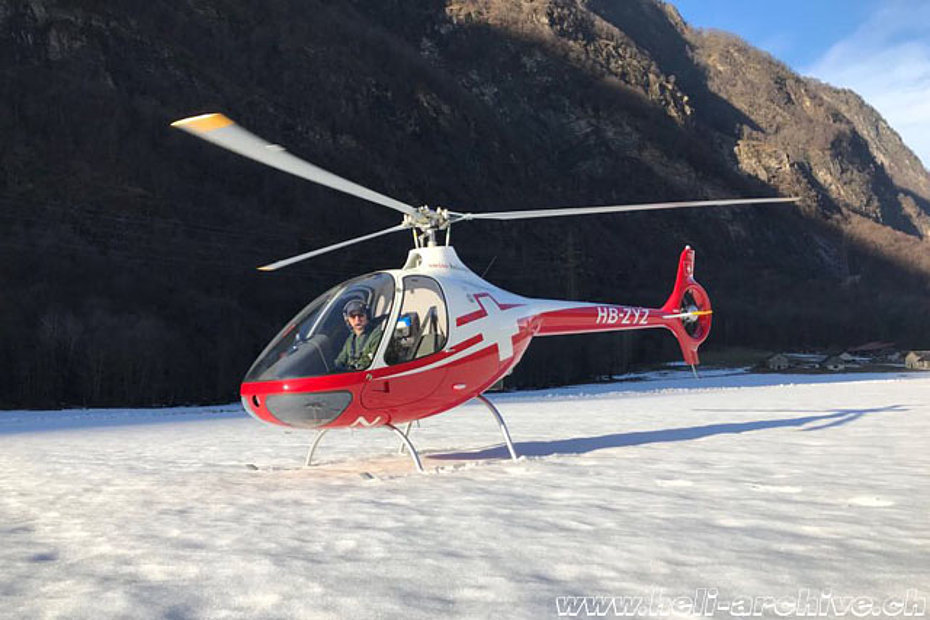
The first Guimbal Cabri G2s to be registered in Switzerland were HB-ZTT (s/n 1022) entered into service on behalf of Helitrans AG in March 2011, HB-ZLS purchased in April 2011 by Air Grischa Helikopter AG and HB-ZLJ entered service with Heliswiss Schweizerische Helikopter AG in May 2011.
There are currently 10 Cabris in service in Switzerland, 5 of them in service with Swiss Helicopter AG. This operator replaced the Schweizer 300C previously used for the training school.
Did you know that…
In 2015, after the Heli-Expo in Orlando (Florida), the second Guimbal Cabri G2 exported to the United States (N371PA) carried out a 6,000 km (3,200 miles) trip before being delivered to Precision Helicopters, the first US Cabri operator and distributor. The helicopter took-off in Orlando and reached Portland in Oregon after crossing 12 states. During the long transfer many new or potential customers and service centers were visited and the helicopter performed 14 demonstration flights. Altogether the crew made 42 stops.
Interesting link
Last but not least have a look to the website of Hélicoptères Guimbal: https://www.guimbal.com/
HAB 04/2018


